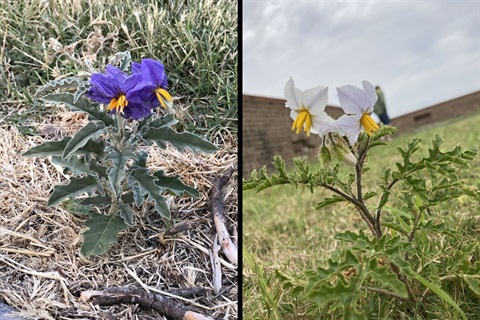
Welcome to the seventh article in our Weed of the Week series, where we're sharing information on our region's priority weeds.
This week we look at two potential new weed threats to the Snowy Monaro's prime grazing country – Silverleaf Nightshade and Sticky Nightshade.
Snowy Monaro Regional Council is calling on all community members to get to know weed species that can impact our region, so we can all play our part in protecting our environment, helping our farmers and supporting our community.
The impact of weeds on our community can be devastating and is estimated to cost the NSW economy about $1.8 billion annually (NSW Department of Industry, 2018).
What are Silverleaf Nightshade and Sticky Nightshade?
Silverleaf Nightshade (Solanum elaeagnifolium) is a Weed of National Significance and is prohibited from being sold, bartered, exchanged or offered for sale anywhere in the state of New South Wales.
The plant grows upright year-round and ranges from 10cm to 1m in height, with prickly stems and silvery hair-covered leaves and stems. The leaves have wavy edges and can grow up to 15cm long and 0.5 to 2.5cm wide.
Flowers grow in a star shape with five petals. Colouration ranges from blue, through pale lavender to white. The inside of the flower contains yellow stamens and a pistil.
The plant produces toxic berries that will last through winter, with colourations proceeding through green to yellow to orange to red and finally brown.
Sticky Nightshade (Solanum sisymbriifolium) is a similarly upgright-growing plant. It is covered in prickles, grows sticky leaves, and produces red berries.
It can grow to a height of 1.5m, with prickles covering almost all of the plant and typically flowers during spring and summer. Leaves are sticky and green-yellow in colour, growing 5-14cm long and 4-10cm wide. They have deep lobes, hair, prickles, and grow from 4cm long stems.
Flowers grow in a star shape with five petals. Colouration is either white or blue/purple in colour, with central yellow anthers.
Berries are red when ripe and are suspected to be toxic to stock.
Where are these Nightshade species currently situated?
Both Nightshade species have established in areas west of the Great Dividing Range, though neither species is known to exist in significant numbers within the Snowy Monaro Region.
Preventing the introduction of such a weed threat or eliminating it in its early stages of invasion provides significantly greater return on investment than trying to manage a well-established weed.
For this reason, Council calls on community members to learn how to identify these species and immediately report suspected incursions to Council's Biosecurity team.
Why are Silverleaf Nightshade and Sticky Nightshade a problem?
Both Nightshades can:
- Significantly reduce summer crop yields through direct competition
- reduce winter crop yields by depleting soil moisture
- invade pasture and reduce sub-clover growth
- reduce annual pasture growth in autumn and winter
- poison stock if they eat ripe berries
- be expensive to control
- spread easily though both seeds and tiny plant fragments
Additionally, Sticky Nightshade has sharp prickles which can injure people, pets, livestock and native animals.
What must you do if you detect Silverleaf or Sticky Nightshade on your land?
The Draft South East Regional Strategic Weed Management Plan 2023-2027 specifies that both Nightshade species are to be eradicated. This objective applies to all land within the Snowy Monaro region.
What can you do?
- Learn to identify Silverleaf Nightshade and Sticky Nightshade and seek immediate advice if it is identified on your property
- If introducing stock onto your land, hold them in a controlled and observable space for two weeks before moving them into clean pasture
- Clean machinery
- Carefully consider where you source hay, grain and other supplies
- Consider weed risk when agisting stock on or off your property
- Maintain strong, competitive pastures to help suppress weed seedlings
- Do not let grazing livestock eat fruiting plants
- Contact Council's Biosecurity officers if you suspect the presence of these Nightshade species. Our staff provide a free, onsite weed identification and advisory service.
Download the free NSW WeedWise app for detailed information on how to identify and manage local priority weeds. Visit www.dpi.nsw.gov.au/biosecurity/weeds
Visit Council's website to understand how we can help you with weed management. www.snowymonaro.nsw.gov.au/Environment-Waste-and-Weeds/Biosecurity-and-Weeds






